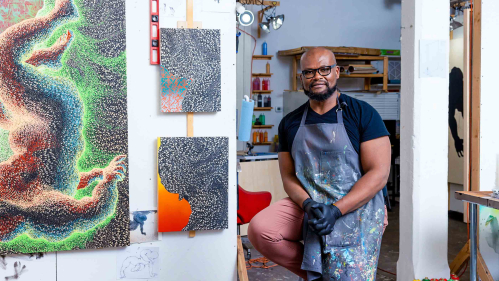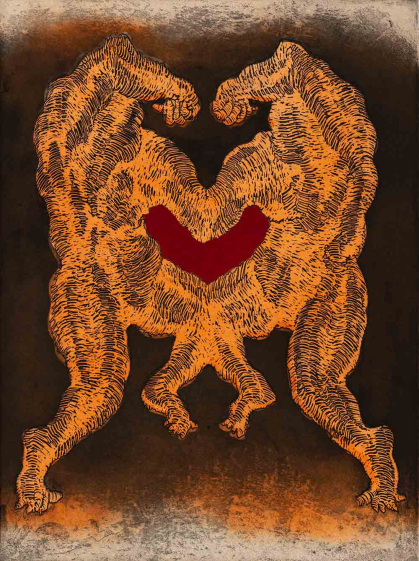A Conversation About the History of Western Art With Didier William

The Mason Gross professor will discuss an exhibit of his work at the Zimmerli Art Museum
A Rutgers professor will discuss his mixed-media paintings and the work of fellow Haitian American artist Paul Gardère at the Zimmerli Art Museum next week.
Didier William, an assistant professor of expanded print at the Mason Gross School of the Arts at Rutgers University–New Brunswick, and others will talk about the Zimmerli’s latest exhibition, Repossession: Didier William and Paul Gardère, and how the two artists confront the history of colonialism in their art. The event is set from 4 p.m. to 6 p.m. Friday, Feb. 23, at the art museum, 71 Hamilton St., New Brunswick. Admission is free but seating is limited; attendees are asked to register.
William will be joined by Erica Moiah James, a scholar of Caribbean art and an assistant professor at the University of Miami, and Cat Gardère, the daughter of the late Paul Gardère and director of his estate.

Zimmerli officials noted in promotional materials how William and Gardère “use multilayered visual vocabularies to explore their personal histories and heritage and the fluid construction of identity within diasporic communities,” adding the exhibition “reevaluates our understanding of the narratives of Western history and art through how William and Gardère confront the long and ongoing history of colonialism to emphatically forge their own identities and create powerful narratives of resistance.”
“With this exhibition, the Zimmerli aims to deconstruct traditional geographical boundaries in art history and bring new voices and diverse perspectives to the museum,” said Nicole Simpson, the associate curator of prints and drawings at the Zimmerli. “In their powerful and visually compelling artworks, Didier William and Paul Gardère combine the personal and the historical to forge dynamic expressions of their Haitian American identity.”
Simpson said museum visitors may learn more about the two artists “and how they create new narratives of resistance” during the talk.
Hailing from Port-au-Prince, Haiti, William earned a bachelor of fine arts degree in painting from the Maryland Institute College of Art and a master of fine arts in painting and printmaking from Yale University. His work has been displayed in the Bronx Museum of Art, the Museum of Latin American Art in Long Beach, Calif., the museum at the Pennsylvania Academy of the Fine Arts and the Fraenkel Gallery in San Francisco, among others. He is represented by James Fuentes Gallery in New York, Altman Siegel Gallery in San Francisco and Galerie Peter Kilchmann in Zurich.
William discussed his art and his inspiration – and offered some advice to art students.

What drew you to painting and printmaking?
I think the hybrid space between painting and printmaking has always been a productive site for me to think about home, belonging and the parameters and consequences of representation, particularly in regard to narratives of immigration.
Which artist inspires you?
I think I and many artists thinking through these ideas owe a great debt to Belkis Ayón. She continues to be an inspiring and profoundly visionary artist.
When you aren’t creating art or teaching college classes at Rutgers, how do you spend your time?
Playing with my daughter and my son, 3 and 1, respectively.
What advice do you have for college students pursuing a fine arts degree?
Above all else, your curiosity is the engine.
Be sure to locate yourself in a space and a community where it will be thoughtfully exercised, protected and challenged.


